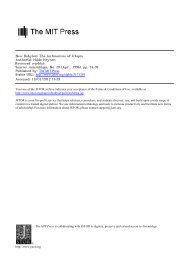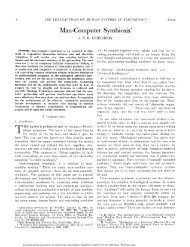Bauhaus Manifesto and Program - The Learning Lab
Bauhaus Manifesto and Program - The Learning Lab
Bauhaus Manifesto and Program - The Learning Lab
You also want an ePaper? Increase the reach of your titles
YUMPU automatically turns print PDFs into web optimized ePapers that Google loves.
Gropius, 1919 <strong>Bauhaus</strong> <strong>Manifesto</strong><br />
training in the crafts, acquired in workshops <strong>and</strong> in experimental <strong>and</strong> practical sites, is required<br />
of all students as the indispensable basis for all artistic production. Our own workshops are to be<br />
gradually built up, <strong>and</strong> apprenticeship agreements with outside workshops will be concluded.<br />
<strong>The</strong> school is the servant of the workshop, <strong>and</strong> will one day be absorbed in it. <strong>The</strong>refore<br />
there will be no teachers or pupils in the <strong>Bauhaus</strong> but masters, journeymen, <strong>and</strong> apprentices.<br />
<strong>The</strong> manner of teaching arises from the character of the workshop: Organic forms<br />
developed from manual skills.<br />
Avoidance of all rigidity; priority of creativity; freedom of individuality, but strict study<br />
discipline.<br />
Master <strong>and</strong> journeyman examinations, according to the Guild Statutes, held before the<br />
Council of Masters of the <strong>Bauhaus</strong> or before outside masters.<br />
Collaboration by the students in the work of the masters. Securing of commissions, also<br />
for students.<br />
Mutual planning of extensive, Utopian structural designs-public buildings <strong>and</strong> buildings<br />
for worship-aimed at the future. Collaboration of all masters <strong>and</strong> students-architects, painters,<br />
sculptors-on these designs with the object of gradually achieving a harmony of all the component<br />
elements <strong>and</strong> parts that make up architecture.<br />
Constant contact with the leaders of the crafts <strong>and</strong> industries of the country. Contact with<br />
public life, with the people, through exhibitions <strong>and</strong> other activities.<br />
New research into the nature of the exhibitions, to solve the problem of displaying visual<br />
work <strong>and</strong> sculpture within the framework of architecture.<br />
Encouragement of friendly relations between masters <strong>and</strong> students outside of work;<br />
therefore plays. lectures, poetry, music, costume parties. Establishment of a cheerful ceremonial<br />
at these gatherings.<br />
Range of Instruction<br />
Instruction at the <strong>Bauhaus</strong> includes all practical <strong>and</strong> scientific areas of creative work.<br />
A. Architecture,<br />
B. Painting,<br />
C. Sculpture<br />
including all branches of the crafts.<br />
Students are trained in a craft (1) as well as in drawing <strong>and</strong> painting (2) <strong>and</strong> science <strong>and</strong> theory<br />
(3).<br />
1. Craft training-either in our own, gradually enlarging workshops or in outside workshops to<br />
which the student is bound by apprenticeship agreement-includes:<br />
a) sculptors, stonemasons, stucco workers, woodcarvers, ceramic workers, plaster casters,<br />
b) blacksmiths, locksmiths, founders, metal turners,<br />
c) cabinetmakers,<br />
d) painter-<strong>and</strong>-decorators, glass painters, mosaic workers, enamelers,<br />
e) etchers. wood engravers, lithographers, art printers, enchasers,<br />
f) weavers.<br />
Craft training forms the basis of all teaching at the <strong>Bauhaus</strong>. Every student must learn a craft.<br />
2




